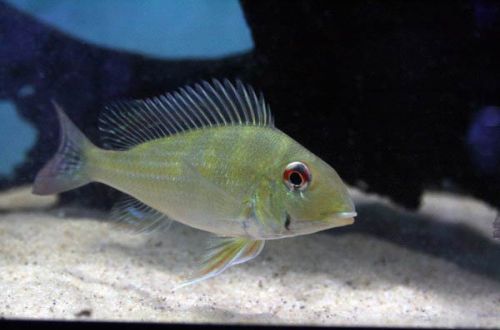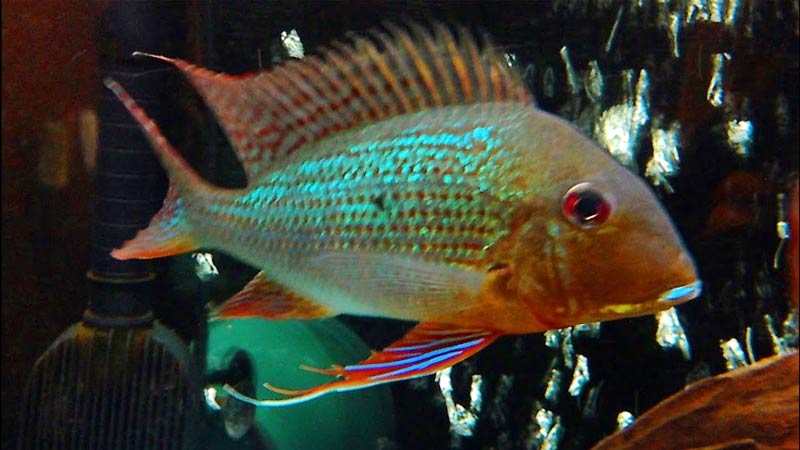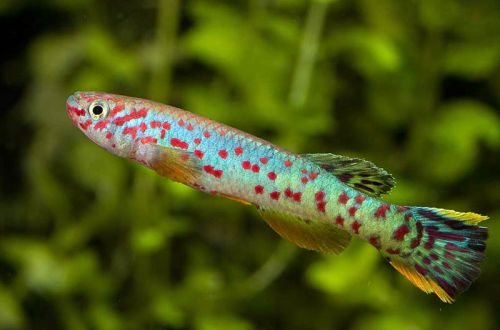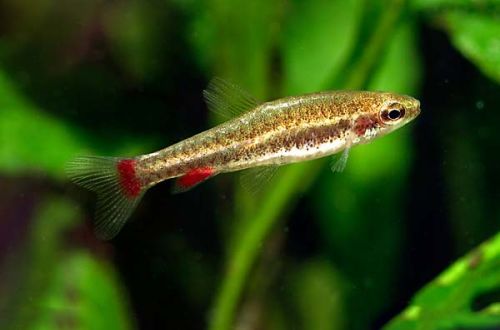
Geophagus surinamese
Geophagus surinamensis, scientific name Geophagus surinamensis, belongs to the family Cichlidae (Cichlids). Unpretentious and easy to maintain, provided that it is in a spacious aquarium. Limited compatibility with species of similar size.

The name of this fish is often erroneously used in relation to another species – the Spotted Geophagus, which lives in a different region and is more modest in size.
Contents
Habitat
Native to South America. It occurs in a limited area of the basins of the Maroni, Suriname and Saramacca rivers on the territory of the modern states of Suriname and French Guiana.
Inhabits tributaries and main channels of rivers. Prefers regions with slow flow and sandy silty substrates. Keeps mainly in the bottom layer.
Brief information:
- The volume of the aquarium – from 600 liters.
- Temperature – 22-26°C
- Value pH — 4.0–7.0
- Water hardness – 1–10 dGH
- Substrate type – sandy
- Lighting – subdued
- Brackish water – no
- Water movement is weak
- The size of the fish is up to 30 cm.
- Food – any sinking food
- Temperament – conditionally peaceful
- Content in a group of at least 5–8 individuals
Description

Adults can exceed 30 cm in length. The fish have a high narrow body and a large head. Coloration varies from olive green to pearl gray with iridescent blue-green stripes on the sides. In the natural habitat, there are also additional red stripes in the body pattern, which disappear in the aquarium. Sexual dimorphism is weakly expressed, males do not differ externally from females.
Food
The daily diet consists of a variety of foods. For example, dry sinking food (flakes, granules), fresh and frozen invertebrates (brine shrimp, bloodworms, daphnia, etc.). It feeds at the bottom by sifting portions of the soil in search of food particles.
Maintenance and care, arrangement of the aquarium
The optimal size of the aquarium for 5-8 fish starts from 500-600 liters. In the design, it is imperative to use a sandy substrate, which is necessary for normal nutrition. The presence of shelters in the form of caves and grottoes from heaps of stones and rocks, as well as large snags, is welcome. The lighting is subdued. Due to the fact that Geophaguses sift the soil, when choosing living plants, preference should be given to unpretentious shade-loving species with a powerful root system or those that can grow on the surface of snags or stones.
Keeping the Surinam Geophagus does not cause much difficulty if the aquarium is equipped with all the necessary equipment (filtration and heating system, lighting, etc.) and regular maintenance procedures are carried out. The latter, in particular, include the weekly replacement of part of the water with fresh and regular removal of organic waste (uneaten food residues, excrement, etc.)
Behavior and Compatibility
Calm fish, except during spawning periods, when Geophagus become aggressive in an effort to protect the clutch and their offspring. Since in a favorable environment spawning can happen several times a year, it is worth picking up large but harmless fish that can withstand temporary attacks as neighbors. For example, it can be other South American cichlids, plecostomuses and other catfish.
Breeding / breeding
With the onset of the breeding season, the male and female form a temporary pair. The eggs are laid on some hard surface, and after fertilization they immediately end up in the female’s mouth, where they will stay for the entire incubation period. The fry that have appeared will continue to be in this “secluded place”, periodically swimming out for food. Sometimes males join in bearing offspring. Until the juveniles become independent, their parents jealously protect them.
Fish diseases
The main cause of most diseases lies in the conditions of detention, if they go beyond the acceptable range, then immunity suppression inevitably occurs and the fish becomes susceptible to various infections that are inevitably present in the environment. If the first suspicions arise that the fish is sick, the first step is to check the water parameters and the presence of dangerous concentrations of nitrogen cycle products. Restoration of normal/suitable conditions often promotes healing. However, in some cases, medical treatment is indispensable. Read more about symptoms and treatments in the Aquarium Fish Diseases section.





